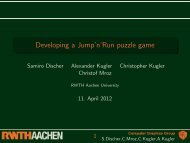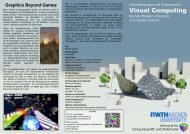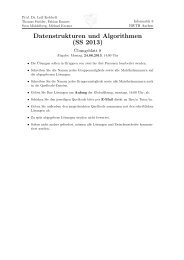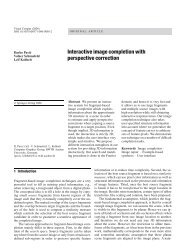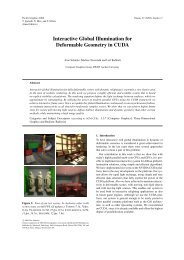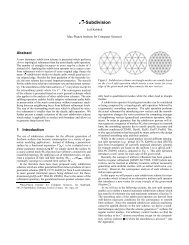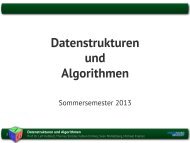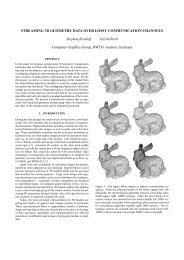Structure Preserving CAD Model Repair - OpenFlipper
Structure Preserving CAD Model Repair - OpenFlipper
Structure Preserving CAD Model Repair - OpenFlipper
Create successful ePaper yourself
Turn your PDF publications into a flip-book with our unique Google optimized e-Paper software.
Stephan Bischoff & Leif Kobbelt / <strong>Structure</strong> <strong>Preserving</strong> <strong>CAD</strong> <strong>Model</strong> <strong>Repair</strong><br />
whether the current triangle really intersects the cell using<br />
the separating axis theorem.<br />
successful, we calculate the real intersection point using exact<br />
arithmetics. Analogous considerations apply for triangleedge<br />
intersections, edge-edge intersections, triangle-cell intersections,<br />
etc.<br />
Initial configuration<br />
Phase I<br />
3.5. Reconstruction<br />
We now present an algorithm to reconstruct the surface in<br />
the interior of the critical cells. This algorithm uses elements<br />
of the feature–sensitive marching cubes and dual contouring<br />
algorithms that were proposed by Kobbelt et al. [KBSS01]<br />
and Ju et al. [JLSW02] and later extended by Varadhan et<br />
al. [VKK ∗ 03] to arbitrary grids of directed distances. However,<br />
in addition to being feature-sensitive, our algorithm can<br />
also handle multiple cuts per edge and seamlessly connects<br />
the reconstruction inside the critical cells to the outside geometry.<br />
Phase II<br />
Phase III<br />
Figure 6: Initial configuration: A triangle mesh is to be<br />
clipped against a set of critical grid cells. Phase I: The intersections<br />
of the grid edges with the triangles are inserted<br />
into the mesh by 1-to-3-splits or 2-to-4-splits. Phase II: The<br />
intersections of mesh edges and grid faces are inserted by<br />
2-to-4-splits. Now each triangle either lies completely inside<br />
or completely outside the set of critical grid cells. Phase III:<br />
The interior triangles are discarded.<br />
Implementation The algorithm above only works if intersections<br />
are reliably detected and correctly calculated. However,<br />
just switching to exact arithmetics will extremely slow<br />
down the algorithm. For this reason, we use a mixed representation.<br />
Let the positions of the input vertices of the model<br />
be quantized to N bits. For each vertex v, we store<br />
• its exact position p exact,v using an adaptive precision representation<br />
[Pri91, She97].<br />
• its approximate position p approx,v using a fixed point representation<br />
of N bits width<br />
such that (remember that the extent of the grid is 2 k ):<br />
||p exact,v − p approx,v|| < η := 2 k−N<br />
We can then use the approximate positions for evaluating<br />
“easy rejects” when computing intersection points. Consider<br />
for example the intersection of an edge e and a grid face<br />
f = [f min ,f max]. We first check whether e approx intersects the<br />
box<br />
[f min − (η,η,η) T ,f max + (η,η,η) T ]<br />
This test can exactly be evaluated in fixed-point arithmetics<br />
using a maximum of 3N bits only [Ju04]. Only if this test is<br />
We first enumerate all interior grid faces, again using a<br />
recursive octree traversal technique. For each interior grid<br />
face, we collect the cuts that are located on the edges of this<br />
face. Note that a grid edge might support more than two cuts,<br />
if a single patch intersects that edge multiple times. By construction,<br />
the number of cuts is always even. Furthermore,<br />
cuts pointing in clockwise (cw) direction alternate with cuts<br />
pointing in counter-clockwise (ccw) direction. We now connect<br />
these cuts by edges: a cw cut is connected to the next<br />
ccw cut by going ccw around the grid face (Figure 7, left),<br />
see also [Blo88, NH91]. If we connect two cuts from the<br />
same grid edge, we insert an auxiliary point at the face center<br />
to prevent topological degeneracies. Note that by construction,<br />
the edges do not intersect.<br />
We then visit each critical cell in turn. The edges on the<br />
cell’s faces were either created as described above or are<br />
boundary edges of the outside geometry. In any case, these<br />
edges form one or more connected loops around the cell.<br />
Each of these loops is triangulated by a triangle fan (Figure<br />
7, right). As the edges do not intersect, the loops will<br />
also be free of intersections and so are the triangle fans.<br />
Figure 7: We connect the cuts incident to a grid face by<br />
edges (left). For each grid cell these edges and the boundary<br />
edges of the outside geometry form loops around the<br />
cell. Each of these loops is triangulated by a fan of triangles<br />
(right).<br />
c○ The Eurographics Association and Blackwell Publishing 2005.



